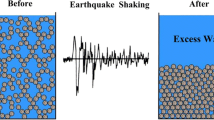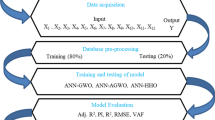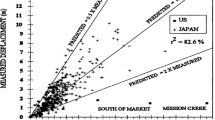Abstract
In this study, a genetic algorithm with global searching capability was incorporated into a neural network calculating process to obtain a highly reliable model for predicting peak ground acceleration, which is the key element in evaluating earthquake response and in establishing a seismic design standard. In addition to three seismic parameters (i.e. local magnitude, focal distance, and epicentre depth), this study included two geological conditions (i.e. standard penetration test value and shear-wave velocity) in the input to reflect the site response adequately. Based on the earthquake records and soil test data from 86 checking stations, within 24 seismic subdivision zones in the Taiwan area, the computational results show that using a combination of a neural network and genetic algorithm can achieve a higher performance compared with solely using a neural network model. Furthermore, a weight-based model was developed for predicting peak ground acceleration at an unmonitored site to represent each subdivision zone. The results show that three subdivision zones have higher horizontal peak ground accelerations than the seismic design value as required in the building code. The obtained information might be helpful in relevant engineering applications for the studied region, and the proposed method for treating this type of nonlinear seismic data might be applicable in other areas of interest worldwide.











Similar content being viewed by others
References
USGS (2012) Earthquake glossary: ring of fire. United States Geological Survey. http://earthquake.usgs.gov/learn/glossary/?termID=150
Bartels SA, VanRooyen MJ (2012) Medical complications associated with earthquakes. Lancet 379:748–757
Bailey IW, Becker TW, Ben-Zion Y (2009) Patterns of co-seismic strain computed from southern California focal mechanisms. Geophys J Int 177(3):1015–1036
Bensen GD, Ritzwoller MH, Barmin MP, Levshin AL, Lin F, Moschetti MP, Shapiro NM, Yang Y (2007) Processing seismic ambient noise data to obtain reliable broad-band surface wave dispersion measurements. Geophys J Int 169:1239–1260
Liu G, Fomel S, Chen X (2011) Time-frequency analysis of seismic data using local attributes. Geophysics 76(6):23–34
Rhoades DA, Evison FF (2004) Long-range earthquake forecasting with every earthquake a precursor on its own scale. Pure appl Geophys 161:47–72
Wu YM, Kanamori H (2008) Development of an earthquake early warning system using real-time strong motion signals. Sensors 8(1):1–9
Zobin VM, Bretón M, Navarro C (2014) Similarity in seismic source scaling relations for tectonic and volcanic processes. Phys Earth Planet Inter 231:65–73
Yuen KV (2010) Bayesian methods for structural dynamics and civil engineering. Wiley, New Jersey (ISBN: 978-0-470-82454-2)
Yuen KV, Mu HQ (2011) Peak ground acceleration estimation by linear and nonlinear models with reduced order Monte Carlo simulation. Comput Aided Civ Infrastruct Eng 26(1):30–47
García SR, Romo MP, Mayoral JM (2007) Estimation of peak ground accelerations for Mexican subduction zone earthquakes using neural networks. Geofís Int 46(1):51–63
Panakkat A, Adeli H (2007) Neural network models for earthquake magnitude prediction using multiple seismicity indicators. Int J Neural Syst 17(1):13–33
Tselentis GA, Vladutu L (2010) An attempt to model the relationship between MMI attenuation and engineering ground-motion parameters using artificial neural networks and genetic algorithms. Nat Hazards Earth Syst Sci 10:2527–2537
Kerh T, Lai JS, Gunaratnam D, Saunders R (2008) Evaluation of seismic design values in the Taiwan building code by using artificial neural network. CMES Comput Model Eng Sci 26(1):1–12
Vonk E, Jain LC, Johnson RP (1997) Automatic generation of neural network architecture using evolutionary computation. World Scientific, Singapore
Cook DF, Ragsdale CT, Major RL (2000) Combining a neural network with a genetic algorithm for process parameter optimization. Eng Appl Artif Intell 13:391–396
Saemi M, Ahmadi M, Varjani AY (2007) Design of neural networks using genetic algorithm for the permeability estimation of the reservoir. J Petrol Sci Eng 59:97–105
Tarca LA, Grandjean BPA, Larachi F (2002) Integrated genetic algorithm-artificial neural network strategy for modeling important multiphase-flow characteristics. Ind Eng Chem Res 41(10):2543–2551
Kerh T, Gunaratnam D, Chan Y (2010) Neural computing with genetic algorithm in evaluating potentially hazardous metropolitan area result from earthquake. Neural Comput Appl 19(4):521–529
Kerh T, Chan Y, Gunaratnam D (2009) Treatment and assessment of nonlinear seismic data by a genetic algorithm based neural network model. Int J Nonlinear Sci Numer Simul 10(1):45–56
Central Geological Survey (2013) Taiwan faults. Ministry of Economic Affairs. http://www.moeacgs.gov.tw/app/index.jsp
Chen TH, Chang WY (2012) Analysis of earthquake activities in Taiwan area (iv). Central Weather Bureau, MOTC-CWB-101-E-12 62:325–346
Norris RB (2010) Quemoy and Matsu: a historical footnote revisited. American Diplomacy, Chapel Hills
Tsai H, Young CF (2004) Taiwan faults and earthquakes. Yunzu Culture Business Company Limited, Taipei, pp 15–35
Construction and Planning Agency (2006) Building code. Ministry of the Interior, Taiwan. http://www.cpami.gov.tw
Chen PY (2006) Geology of Taiwan. Chenyang Publishing Company Limited, Taipei, pp 3–7
Wikipedia (2014) Standard penetration test. Wikimedia Foundation Incorporation. http://en.wikipedia.org/wiki/Standard_penetration_test
Wikipedia (2014) S-wave. Wikimedia Foundation Incorporation. http://en.wikipedia.org/wiki/S-wave
Chang FJ, Chang LC (2010) Introduction to artificial neural networks: principle and application. Tsanghai Publishing, Taichung
Pu Y, Mesbahi E (2006) Application of artificial neural networks to evaluation of ultimate strength of steel panels. Eng Struct 28:1190–1196
Shanga Z (2005) Application of artificial intelligence CFD based on neural network in vapor-water two-phase flow. Eng Appl Artif Intell 18:663–671
Mandic D, Chambers J (2001) Recurrent neural networks for prediction: architectures, learning algorithms and stability. Wiley, New York
Wu S, Chou L, Lee S, Chang BZ (2003) MATLAB neural networks simulation and application. Science Publishing Company, China
Wikipedia (2014) Genetic algorithm. Wikipedia Foundation Incorporation. http://en.wikipedia.org/wiki/Genetic_algorithm
Harpham C, Dawson CW, Brown MR (2004) A review of genetic algorithms applied to training radial basis function networks. Neural Comput Appl 13(3):193–201
Gowda CC, Mayya SG (2014) Comparison of back propagation neural network and genetic algorithm neural network for stream flow prediction. J Comput Environ Sci. doi:10.1155/2014/290127
Liu D (2014) Network site optimization of reverse logistics for E-commerce based on genetic algorithm. Neural Comput Appl 25(1):67–71
Patra SR, Jehadeesan R, Rajeswari S, Murty SAVS, Bab MS (2012) Development of genetic algorithm based neural network model for parameter estimation of fast breeder reactor subsystem. Int J Soft Comput Eng 2(4):87–90
Zhang Y, Gao X, Katayama S (2015) Weld appearance prediction with BP neural network improved by genetic algorithm during disk laser welding. J Manuf Syst 34:53–59
User’s Guide (2004) GeneHunter targets optimal solutions with genetic. Ward Systems Group Incorporation, Maryland
Yeh YC (2004) Applied artificial neural networks. Scholar Books Company Limited, Taipei, pp 3–7
Ma SL, Wu TB (2009) Statistics: using SPSS for Windows. New Wun Ching Developmental Publishing Company Limited, Taipei, pp 174–188
Kerh T, Chu D (2002) Neural network approach and microtremor measurement in estimating peak ground acceleration due to strong motion. Adv Eng Softw 31:367–375
Kerh T, Ting SB (2005) Neural network estimation of ground peak acceleration at stations along Taiwan high-speed rail system. Eng Appl Artif Intell 18:857–866
Hong TG (2004) Dynamics of structures. Tienyu Publishing Incorporation, Taipei, pp 8–12
Kerh T, Lin Y, Saunders R (2013) Seismic design value evaluations based on checking records and site geological condition using artificial neural networks. Abstr Appl Anal. doi:10.1155/2013/242941
Acknowledgments
Financial support from the Ministry of Science and Technology is greatly appreciated. The authors also gratefully acknowledge the Central Weather Bureau Seismological Center and National Center for Research on Earthquake Engineering of Taiwan for providing historical seismic records and geological surveys, respectively. In addition, the improvement of English by Mr. Wesley Jantjies with Wallace Academic Editing is acknowledged.
Author information
Authors and Affiliations
Corresponding author
Rights and permissions
About this article
Cite this article
Kerh, T., Su, YH. & Mosallam, A. Incorporating global search capability of a genetic algorithm into neural computing to model seismic records and soil test data. Neural Comput & Applic 28, 437–448 (2017). https://doi.org/10.1007/s00521-015-2077-7
Received:
Accepted:
Published:
Issue Date:
DOI: https://doi.org/10.1007/s00521-015-2077-7




